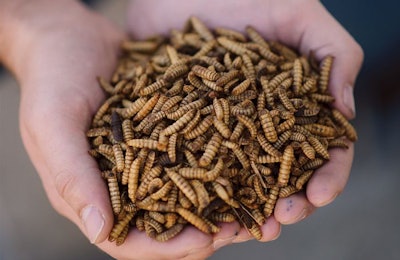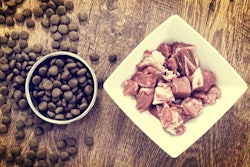
The larvae of an insect, the black soldier fly, are creeping closer to both regulatory and societal acceptance as a pet food protein source in the US. Worldwide, the larvae may have economic and environmental advantages over some conventional livestock, and could even help fight climate change. What’s more, black soldier fly larvae farms may create opportunities for both small and large entrepreneurs and workers.
“I want the pet food industry to know that this is a tremendous opportunity to do something that could reduce costs to their industry while protecting the environment and creating jobs at the same time,” said Jeffery K. Tomberlin, PhD, associate professor and AgriLife research fellow in the department of entomology at Texas A&M University and chairman of EVO Conversion Systems.
Nutritional value of insects as pet food protein
“All insects are generally good sources of protein, B-vitamins and trace minerals,” said pet nutrition consultant Mark Finke, PhD. “Much of it depends on exactly what they are to be used for (what is their primary role in a complete and balanced pet food). So black soldier fly larvae would be an excellent source of calcium as well, while crickets are relatively high in taurine. Note that some nutrients can easily be manipulated by diet so in some cases blanket statements should be made with great care.”
Researchers haven’t focused much attention on insects, including black soldier fly larvae, as parts of dogs and cats diets, he said. Biologists have observed that many wild canines and felines include insects in their diets, though. Scientists have studied insects in the diets of fish, poultry and rats, but research in dogs and cats is lagging.
“All indications are that they would be excellent sources of high-quality protein (along with many other essential nutrients) but we are in the very infancy of this, mostly as a result of lagging regulations and in some cases costs are not competitive with more traditional protein sources,” said Finke.
Economic opportunities of black soldier fly larvae
Considering production costs, black soldier fly larvae may have a slightly lower feed-to-protein conversion factor than fish, but the larvae can be grown in smaller spaces, including land that would unsuitable for other animals, said Liz Koutsos, PhD, president of EnviroFlight. Black soldier fly larvae farms can also be scaled-up and grow vertically. EnviroFlight currently uses a small facility while building a larger black soldier fly larvae farm in Kentucky, USA. Koutsos expects the plant to open later in 2018.
“We can have 20, 30 or 40 foot-tall stacks of insects and it's all a matter of just engineering the facility to be safe as far as how tall you want to go,” she said. “You can get a massive amount of production in a very small footprint, whereas with other animals you don't have that capability. The new facility, once it comes online, will be highly automated trying to improve efficiencies of production,” she said. “We designed it to be modular and scalable so we're building it in phases.”
In rural areas of the US and in developing nations, small-scale black soldier fly larvae farms could provide employment and income, said Tomberlin.
“There's a lot of opportunities there for micro-companies,” he said. “The investment at the beginning can be quite minimal. However, it does take having the expertise available to help foster things forward. That's a major thrust of EVO, how to assist startup companies around the world with streamlining their processes.”
Small-scale black soldier fly production plants in rural areas of the US could employ five to 10 people each, he said. When multiplied by a hundred small operations in a region, these facilities could become a significant employer.
“One of EVO’s primary goals is to reach out to the rural settings throughout the US and create job opportunities,” Tomberlin said. “As someone that grew up in rural South Georgia, I've seen what happens to these communities when the textile industry moved out. They need jobs. They need opportunities.”
Environmental benefits of black soldier fly larvae
These new jobs won’t come as a cost to the environment. The insects likely are native to the tropics of the western hemisphere, but are found on every continent except Antarctica. Hence, they aren’t likely to become an invasive species. The larvae require warm temperatures, so if they do escape in the US, winter temperatures will kill them off.
Black soldier flies aren’t a threat to local ecosystems, nor to human health. Koutsos said that the insects don’t carry zoonotic diseases (those that animals transmit to humans) and the adults don’t even have working mouth parts, so they can’t even annoy people with their bites.
To the contrary, black soldier flies may benefit human and ecosystem health by reducing pollution and foul odors created by pre-consumer waste. Although exact figures depend on a number of variables and need more research, black soldier fly larvae may reduce carbon dioxide emissions by approximately half a pound for every pound of protein produced, Tomberlin said.
That reduction comes about because the larvae eat pre-consumer waste, such as scraps from vegetable processing plants or spent grains from distilleries. The larvae produce less carbon dioxide than the microbes that would otherwise break down those leftovers. Along with protecting the global environment, the larvae can make the local environment less funky.
Many of the noxious odors from decomposing plant materials are greatly reduced when black soldier fly larvae do the job of breaking down food wastes, he said. The larvae could break down other wastes, such as animal manure, but then the protein for the larvae couldn’t be used in animal feed or human food. American Association of Feed Control Officials (AAFCO) regulations prohibit the use of manure or post-consumer food waste.
Regulation and acceptance of black soldier fly larvae in pet food
Black soldier fly larvae’s food isn’t the only thing regulated by AAFCO. Most uses of the larvae themselves await approval.
“The tentative approval for black soldier fly larvae meal (defatted larvae) in salmonid diets in the US at the January 2018 AAFCO meeting was very exciting because it lays the groundwork for additional approvals in companion animal, poultry, swine and exotics,” said Koutsos.
So far, only whole larvae have been approved, not ground-up meals, said Tomberlin. He believes that AAFCO approvals will expand to other black soldier fly larvae products. However, it will take time for AAFCO officials to educate themselves so they can make an informed decision on modifications to regulations.
Along with AAFCO, the general public needs education about black soldier fly larvae, he said. Especially in communities where production facilities are set up, local communities need to learn that the insects aren’t a pest, don’t carry zoonotic diseases and won’t become an environmental threat.
As black soldier flies continue to overcome regulatory hurdles, they may also overcome psychological hurdles. As this happens, pet food manufacturers may gain a novel protein source with sustainability credentials.
Read more: Infographic: Insect-based pet food nutrition: www.PetfoodIndustry.com/articles/7060
















